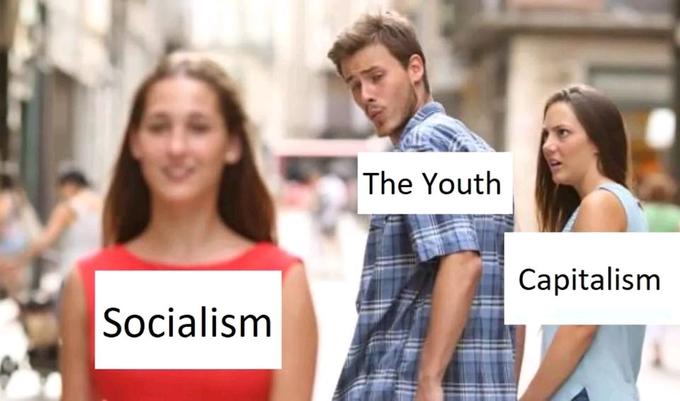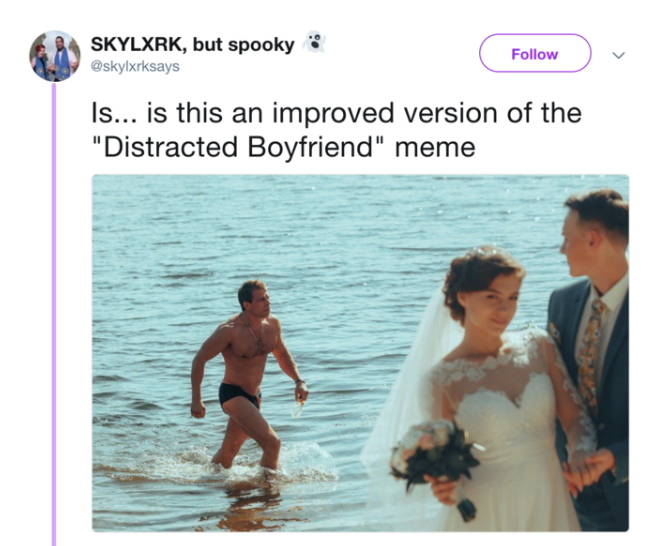Swedish Court Misunderstands Memes (Guest Blog Post)
by guest blogger Stacey Lantagne
Memes are everywhere. Part of the essential communicative fabric of social media, it’s hard to imagine Twitter or Instagram or even texting without them. They get used to react to matters of national debate, sports scores, gossip (celebrity or more personal), and requests to stop at the store for milk before you come home. But their ubiquity means they aren’t just used in personal conversations – schools use them to teach, politicians use them to campaign, and advertisers use them to sell us products.
Memes have muscled their way onto the scene, and recently they’ve been one of the things at the center of much debate concerning the EU’s new copyright law, which could have the potential to stop many of them in their tracks, including my personal favorite, Distracted Boyfriend.
But a recent decision by Sweden’s Advertising Ombudsman (RO), a “self-regulatory advertising watchdog,” attacked the Distracted Boyfriend meme not for its copyrighted status but for something else entirely: sexism. The meme at the time was not being used as a meme, but rather as an advertisement. Seeking applicants for open positions, Bahnhof, a Swedish ISP, used the Distracted Boyfriend meme, casting the girlfriend as “your current workplace” and the woman who catches the boyfriend’s attention as a new job at Bahnhof.
When Bahnhof posted its version of the meme to its Facebook page, it received many comments criticizing its sexism, and the advertisement was referred to RO, which has guidelines against portraying women as “mere sex objects.” RO agreed with the ad’s critics in a unanimous decision, noting that the meme portrayed women as “interchangeable” “sex objects” to men and had “no link” to Bahnhof’s services. The judgment also added that it was offensive that the ad labeled the man as the object at which it was aimed (“you”/“du”), while the women were labeled as the objects to be achieved. The judgment concluded that the ad may discourage women from applying for the indicated jobs.
I feel this decision erred in its refusal to acknowledge that the photograph is no longer a photograph, but a meme, which is something I assert we should be understanding as a completely different creature. RO insisted that it “passes judgments on adverts, not memes.” But the fact that the photograph is a meme should affect how it’s being interpreted. Of course the photograph didn’t have a link to Bahnhof’s business, as RO found, because the photograph wouldn’t. But, as Bahnhof pointed out in its own statement on the issue, the meme did: “We are an internet company and are conversant in this, as are those who would look for a job with us, so we turned to that target group. If we should be punished for anything, it’s for using an old and tired meme.”
Taking this as a photograph instead of recognizing it as a meme is where the trouble in meme legality starts. I argue that there is a type of meme, of which the Distracted Boyfriend is one, whose meaning has mutated through collaborative creativity such that it cannot be treated as a mere photograph anymore. To do so ignores the layers of communicative gloss that its memeification has given it. That’s why this decision can read as so tone-deaf: It’s pretending this is just a photograph, when actually it’s a meme. It’s speaking a completely different language than those who have grown used to this photograph standing in for a much more complex global conversation. Recent discussions calling for closer examination of the messages communicated by memes seems to acknowledge this: It’s not the photographs themselves that are troubling to organizations studying teenage attitudes toward food, but the meaning imbued in the photographs by their memeification.
Memes are hard to describe, and they can be harder still to translate if you are not well-versed in the language of the internet. KnowYourMeme attempts to chronicle the fast-moving, free-wheeling meme vocabulary, providing memes with history and context. As the Distracted Boyfriend entry explains, one of the earliest versions of the meme was a commentary on the youth being lured by socialism away from capitalism – hardly a sexist message.
The photograph might be sexist, but the meme transforms the underlying sexist message into application in a million different situations, from capitalism to the solar eclipse to the Legend of Zelda to meme culture itself. It isn’t that women are interchangeable sex objects; it’s that we’ve all been in a situation where we’ve lost interest in what we have in favor of something new entirely. The original photograph offensively limits that situation to an exchange of interchangeable women; the meme expands the photograph far beyond its limits, implicitly mocking the photograph’s unimaginative limitations in its setup. Why make this photo about men and women, when it could be about anything?
Even the fact that the man is the POV placed at the center of the meme can be understood as part of its commentary: Men are given the starring roles; it’s left to women to rewrite that narrative. Which they do, in meme form, admirably. After all, the meme got its start by recasting the man as “the youth,” immediately demanding that the photograph be read in a much wider, more gender-inclusive way. And, as it’s evolved, versions have developed challenging the gender composition of the original photograph.
I’ve written about the challenges memes present to copyright law. As a quickly evolving method of communication collaboratively created by strangers all over the world, I argue that limiting them to what they were before memeification mutated them does the richness of human communication a disservice. This is why the EU’s copyright laws, in pretending that memes are still just photographs, is so troubling. The distracted boyfriend photograph is of merely passing interest. The meme rose to the top of global conversation last year. It isn’t actually the photograph that went viral, and in circumstances like these, we should meet memes on their own unique terms.




